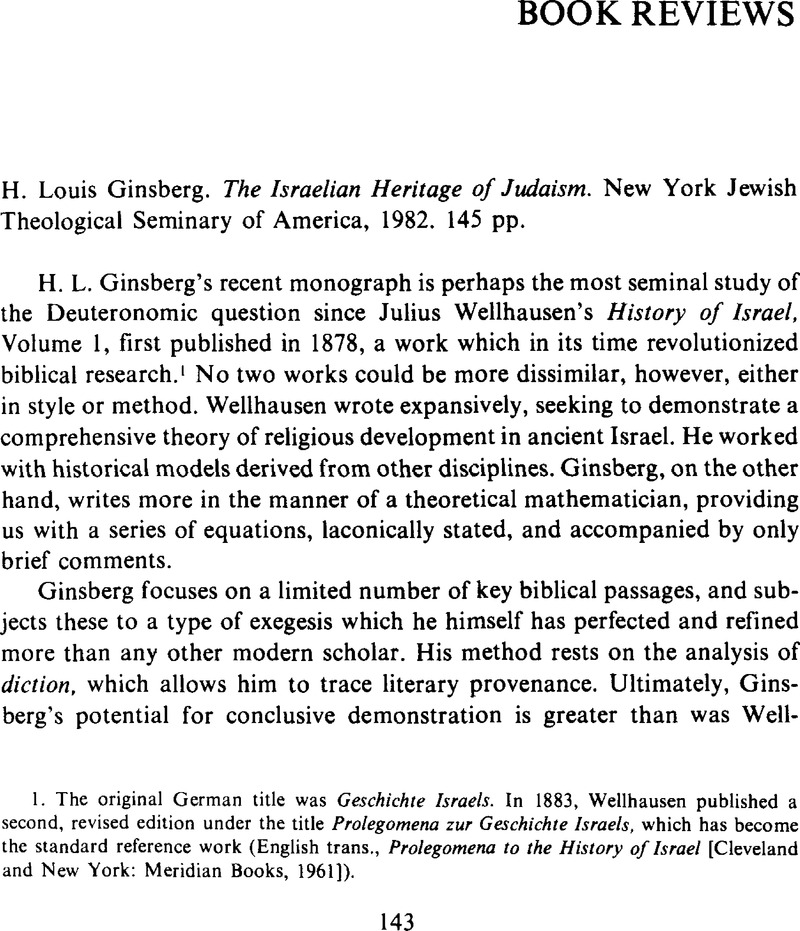No CrossRef data available.
Article contents
H. Louis Ginsberg. The Israelian Heritage of Judaism. New York JewishTheological Seminary of America, 1982. 145 pp.
Published online by Cambridge University Press: 15 October 2009
Abstract

- Type
- Book Reviews
- Information
- Copyright
- Copyright © Association for Jewish Studies 1987
References
1. The original German title was Geschichte Israels. In 1883, Wellhausen published a second, revised edition under the title Prolegomena zur Geschichte Israels, which has become the standard reference work (English trans., Prolegomena to the History of Israel [Cleveland and New York: Meridian Books, 1961]).
2. Perhaps the best representative discussion of the Deuteronomic question is to be found in Weinfeld, M.teronomy and the Deuteronomic School (Oxford, 1972). Ginsberg's monograph will, however, require serious modification of Weinfeld's treatment.Google Scholar
3. A fairly elaborate description of such a cult-installation is found in I Samuel 9.
4. For examples see I Kings 22:44, II Kings 12:14, 14:4, 15:4, 35, etc.
5. I prefer to see the botanical metaphor as moving quickly to the people of Israel. NJPS translates: “Now that his boughs are broken up, ” etc. This rendering takes its cue from II Sam. 18:14, where bĕlēbh hā′elāh means “in thethick growth of the terebinth.” The verb ḥālaqis taken in the usual sense of “dividing, splitting off, or the like.” The translation given here posits a second root in biblical Hebrew: ḥālaq,cognate to Akkadian ḥalāqu, “to disappear, vanish, to become missing or lost, to perish” (see the Assyrian Dictionary[University of Chicago], vol. 6 (Ḥ), 36 f.). This root is probably attested elsewhere in biblical Hebrew, unbeknown to most (cf. the niphal form in Gen. 14:15, as an example). The sense here is that the metaphor, having shifted from the vine to the people, speaks of their loss of “heart, ” namely, their loss of devotion or loyalty. For this sense of Hebrew lēbh,see usage in Num. 32:7, 9, II Sam. 15:13, 1 Kings 12:27, etc.
6. Hebrew 'āwen, “iniquity, ” represents a pejorative alteration of the toponymic Beît-'Ēl, “House of God, ” to Beît-′Āen, or just ′Āwen, for the actual town of Beth-El. See Hosea 4:15, 5:8, in addition to our passage.
7. See Hosea 8:11, 10:1–2, 8, 12:2, Amos 3:14. The quantitative correlation reappears later in Jer. 11:13, 17:1, and the problem of numerous altars informs Ezekiel 6, for instance, and is addressed in Kings and Deuteronomistic literature generally.
8. The Masoretic text of v. 1 has beît YHWH, “House of the LORD, ” but NJPS, informed by Ginsberg, suggests that an emendation would yield beît Yisrā′ēl,“House of Israel.” It was Ginsberg who surmised that biblical manuscripts may have registered only a yod(in our case, beît y-), not the entire word, so that an ancient copyist might have misread the intent. See the article by Ginsberg, “Hosea, ” in Encyclopaedia Judaica,vol. 8, cols. 1010 f. For the formula 'ādbhar bērît, “to transgress the covenant, ” see Hosea 6:7, and also Jos. 7:15, 23:16, Judg. 2:20, which are Deuteronomistic in tone.
9. Note this diction in Gen. 41:33, 39, which represents northern Israelite writing (the work of the Elohist), and in Deuteronomistic sources such as Deut. 4:6, I Kings 3:12, Jer. 9:11.




